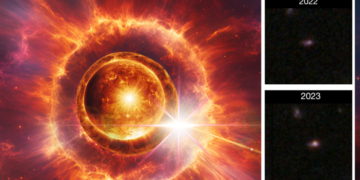The James Webb Space Telescope (JWST) has once again pushed the boundaries of our understanding of the universe by unveiling one of the most distant and earliest supernovas ever observed: AT 2023adsv. This extraordinary discovery, which sheds light on the lives of massive stars in the early cosmos, is a milestone in astronomy, providing valuable insights into the evolution of galaxies and the origins of heavy elements.
A Glimpse into the Early Universe
Supernovas are among the most powerful and awe-inspiring events in the cosmos. They occur when massive stars exhaust their nuclear fuel and erupt in cataclysmic explosions that spread elements into space. AT 2023adsv, however, stands out as an extraordinary example of such an event.
Detected in a galaxy 11.4 billion light-years away, this supernova occurred just 2 billion years after the Big Bang. Researchers observed that the explosion came from a massive star around 20 times the mass of the Sun, unleashing twice the energy of a typical supernova in today’s universe. This suggests that early stellar explosions were fundamentally different from modern ones.
The environment of the early universe likely shaped these unique properties. Unlike stars today, ancient stars were poor in heavy elements, influencing their lifecycles to burn fuel faster and explode more violently. AT 2023adsv’s discovery gives scientists a valuable opportunity to study the stars that seeded the cosmos with the elements necessary for galaxy formation and planetary systems.
How the James Webb Space Telescope Made This Possible
The JWST’s state-of-the-art infrared capabilities are revolutionizing our ability to study distant cosmic phenomena. Its ability to detect faint light from billions of years ago allowed astronomers to identify AT 2023adsv and analyze its unique features.
The supernova is part of the JWST Advanced Deep Extragalactic Survey (JADES), which has uncovered over 80 supernovas from the early universe. AT 2023adsv stands out for its brightness and high-energy explosion. The JWST provided detailed data about its chemical composition and the star’s environment, enabling researchers to compare ancient supernovas to modern ones and uncover critical differences.
Observing such distant events requires extraordinary precision, and the JWST’s ability to capture light from billions of years ago acts like a time machine, letting scientists peer into the early stages of the universe’s evolution.
What Makes AT 2023adsv Special?
AT 2023adsv’s environment and energy make it unique. The explosion occurred in a metal-poor galaxy, mirroring the conditions of the early universe. The star’s lifecycle was shaped by this environment, leading to a shorter lifespan and a more intense explosion.
The supernova supports the hypothesis that early explosions were critical in enriching the universe with heavier elements. These elements, in turn, played a vital role in forming new generations of stars and galaxies. By studying AT 2023adsv, scientists are piecing together the puzzle of how the universe transformed from its simple beginnings into the complex structure we observe today.
Implications for Cosmic Evolution
The study of AT 2023adsv is more than a historical insight; it offers a deeper understanding of the processes that have shaped the cosmos. This supernova provides a snapshot of the chemical enrichment process that made it possible for galaxies, solar systems, and eventually life to form.
The explosion of AT 2023adsv underscores the importance of ancient stars in shaping their environments. Their violent deaths spread the elements that would later form planets and even life itself. By examining such events, scientists can refine their models of how galaxies evolve and better understand the factors that determine the habitability of planetary systems.
Why This Discovery Matters
The discovery of AT 2023adsv highlights the power of modern astronomy to uncover the secrets of the universe. This knowledge has far-reaching implications for fields like astrophysics, planetary science, and the search for extraterrestrial life.
Future missions, such as the Nancy Grace Roman Space Telescope, will build on JWST’s findings, enabling even more detailed studies of early cosmic events. These efforts will help identify potential habitable zones in other galaxies and refine our understanding of life’s origins.
This discovery also serves as a reminder of humanity’s enduring curiosity and drive to explore the unknown. By studying the earliest stars, we gain insights not only into cosmic history but also into the fundamental processes that define our existence.
Conclusion
The discovery of AT 2023adsv is a testament to the power of modern technology and the unyielding curiosity of humanity. It offers a rare glimpse into the lives and explosive deaths of massive stars in the early universe, shedding light on the origins of galaxies, stars, and even life itself.
Reference:



















